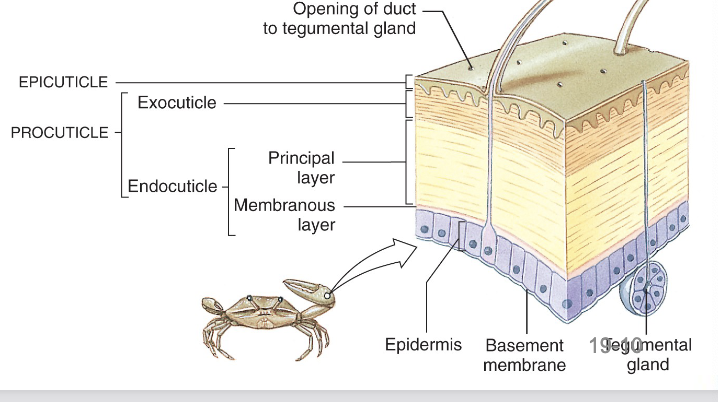Arthropoda
1/21
There's no tags or description
Looks like no tags are added yet.
Name | Mastery | Learn | Test | Matching | Spaced |
|---|
No study sessions yet.
22 Terms
Phylum Arthropoda
The largest phylum in the animal kingdom, encompassing invertebrates with jointed legs, segmented bodies, and exoskeletons, such as insects, arachnids, and crustaceans.
approx. 1,100,00 species recorded
Arthropoda Characteristics: Exoskeleton:
Highly protective, particularly against desiccation
Arthropoda Characteristics: Tagmatization:
Segments fused/modified in different regions of the body for specific functions such as locomotion, reproduction, and feeding.
Arthropoda Characteristics: Efficient gas exchange systems
in terrestrial forms
Suit of Armor
refers to the hard exoskeleton made of chitin that protects and supports arthropods.
Chitin
long chain polymer of a N-acetylglucosamine (derivative of glucose) = inert polysaccharide.
Versatile exoskeleton
made of cuticle
highly protective, jointed
flexible for mobility
consists of: Procuticle (inner thick layer), Epicuticle (outer thin layer)

Epicuticle
Composed of proteins and lipidsthat serves as a waterproof barrier for arthropods, preventing water loss and protecting against environmental factors.
Sclerotization
The process of hardening the exoskeleton in arthropods through the cross-linking of proteins and chitin, providing strength and protection.
Apodemes (like tendons)
are internal structures that provide attachment points for muscles in arthropods, enhancing leverage and movement.

Ecdysis
the shedding of the exoskeleton in arthropods to allow for growth and development. This process is essential as it enables the organism to replace its outer covering and expand its size.
Arthropoda Movement
Refers to the various methods by which arthropods move, including walking, swimming, and flying, often facilitated by their jointed appendages and segmented bodies.
Extrinsic muscles
are muscles that originate outside a limb or body part and attach to it to facilitate movement, playing a significant role in the locomotion of arthropods.
Intrinsic muscles
are muscles located within a limb or body part, allowing for finer control of movement and contributing to the specific functions of the appendages in arthropods.
Circulatory system
of arthropods is an open circulatory system, where blood flows freely through body cavities, bathing organs directly and usually involving a dorsal heart that pumps hemolymph.
Haemocoel
Blood chamber
Haemolymph
Blood that circulates in the open circulatory system of arthropods, serving as a medium for transporting nutrients and waste.
Respiratory System: Terrestrial system
efficient tracheal system of air tubes for direct oxygen transport to tissues and allow high metabolic rates but may limit body size
Respiratory system: Aquatic
respire with various forms of internal or `external gills
Excretory system
Paired excretory glands: coxal, antennal/ maxillary glands that regulate water and waste
Others Malpighian tubules: specialized structures that function in excretion and osmoregulation, particularly in terrestrial arthropods.
Nervous System
Dorsal brain connected by a ring around gullet to a double nerve chain of ventral ganglion that coordinates movement, sensory input, and reflexes in the body.